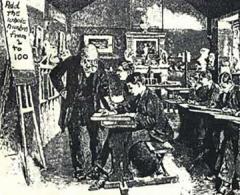
This Article From Issue
May-June 2006
Volume 94, Number 3
Page 197
DOI: 10.1511/2006.59.197
To the Editors:
In the article "A Bright Future for Subwavelength Light Sources" (January-February), Tineke Thio considered a model involving nonresonant evanescent waves diffraction and interferences to explain the typical transmission spectra through hole arrays, which is observed either with metallic or dielectric films.
However, our own work makes clear that the existence of eigenmodes (bound modes) are required to observe the general features of the hole arrays' transmission, although a strong hypothesis on the origin of the eigenmodes was not required.
The eigenmodes related to the film, whatever the material, are resonantly excited by the incident light and converted into transmitted waves (thanks to the film corrugation). These waves interfere with nonresonantly transmitted waves (due to "Bethe" transmission, for instance). As a consequence, the transmission spectra are well depicted as a series of asymmetrical Fano profiles.
According to the contributions of resonant and nonresonant processes, eigenmode resonance wavelengths can be associated either with transmission peaks or dips. This is likely to be the reason for the transmission dependence against the grooves locations (maintaining the same spacing between them) from the central aperture in the circular arrays, as the nonresonant contribution changes.
According to the material properties, one observes various eigenmodes: surface plasmons (metallic films), guided slab modes or Brewster-Zennek surface modes (dielectric films), surface phonon-polaritons (ionic materials in the restrahlen band), "Pendry" surface modes (perfectly conducting materials).
Other authors have also confirmed experimentally or theoretically many of these results.
Michaël Sarrazin
University of Namur, Belgium
Dr. Thio responds:
Many researchers share Dr. Sarrazin's view that a resonance must be implicated in the transmission properties of subwavelength hole arrays. This is entirely reasonable if a hole in an array indeed transmits 1,000 times more light than a solitary hole. However, evidence is accumulating that the enhancement is really at most a factor of 10, and a resonance is not necessary to account for such a modest enhancement. The transmission spectra of hole arrays exhibit a stunning similarity across a large range of geometrical and materials parameters. So instead of indulging in a proliferation of possible resonance modes, let us use Ockham's razor, or the principle of adopting the simplest theory that explains all the observations. The model of diffraction and interference of evanescent waves does the job.

American Scientist Comments and Discussion
To discuss our articles or comment on them, please share them and tag American Scientist on social media platforms. Here are links to our profiles on Twitter, Facebook, and LinkedIn.
If we re-share your post, we will moderate comments/discussion following our comments policy.